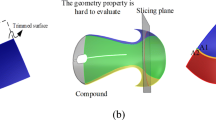Abstract
Toolpath generation and optimization is considered as a challenging problem in the minimally invasive orthopedic surgery with a milling robot. The objective of this paper is to minimize the collision of the cutting tool with the soft tissues. A novel approach of toolpath generation and optimization is proposed. A redundant axis is implemented to avoid the collision in the robot. Some important components are modeled based on the physical requirements. A geometric optimization approach based on the model is proposed to improve the toolpath. Case studies show the validity of this approach. Software is developed for this application and the effectiveness is evaluated with a cadaveric bone.
Access this chapter
Tax calculation will be finalised at checkout
Purchases are for personal use only
Preview
Unable to display preview. Download preview PDF.
Similar content being viewed by others
References
L. Joskowicz, R. Taylor, et al., 1995, Computer Integrated Revision Total Hip Replacement Surgery: Preliminary Report, MRCAS’95, 193–202.
F. Rodriguez, S. Harris, M. Jakopec, A. Barrett, P. Gomes, J. Henckel, J. Cobb and B. Davies, 2005, Robotic clinical trials of uni-condylar arthroplasty, Int J Medical Robotics and Computer Assisted Surgery, 1/4:20–28.
P. Maillet, B. Nahum, L. Blondel, P. Poignet, E. Dombre, 2005, BRIGHT, a Robotized Tool Guide for Orthopaedic Surgery, ICRA2005, 212–217.
J.H. Chung, S.Y. Ko, D.S. Kwon, J.J. Lee, Y.S. Yoon and C.H. Won, 2003, Robot-assisted femoral stem implantation using an intramedulla gauge, IEEE Transaction on Robotics and Automation, 19/5:885–892.
Ch. Plaskos, et al., Safety and Accracy Considerations in Developing a Small Sterilizable Robot for Orthopaedic Surgery, 2005, ICRA2005, 942–947.
K. Morishige, K. Kase and Y. Takeuchi, 1996, The Method of Collision Avoidance for 5-Axis Control Machining Using 2-Dimensional Configuration Space, J. JSPE, 62/1:80–84.
T. Bürger, U. Laible and G. Pritschow, 2001, Design and Test of a Safe Numerical Control for Robotic Surgery, Annals of the CIRP, 50/1:295–298.
Author information
Authors and Affiliations
Editor information
Editors and Affiliations
Rights and permissions
Copyright information
© 2008 Springer-Verlag London Limited
About this paper
Cite this paper
Sugita, N., Osa, T., Nakajima, Y., Mitsuishi, M. (2008). Optimization of Toolpath Generation in Medical CAM for a Machine Tool for Orthopedic Surgery. In: Mitsuishi, M., Ueda, K., Kimura, F. (eds) Manufacturing Systems and Technologies for the New Frontier. Springer, London. https://doi.org/10.1007/978-1-84800-267-8_82
Download citation
DOI: https://doi.org/10.1007/978-1-84800-267-8_82
Publisher Name: Springer, London
Print ISBN: 978-1-84800-266-1
Online ISBN: 978-1-84800-267-8
eBook Packages: EngineeringEngineering (R0)




